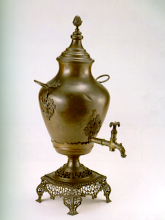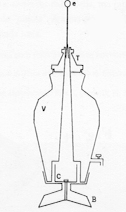
28 x 54 x 26.5
Copper, iron, wood and brass
INDEX 1788 : O.I.257
Vas Cupreum epistomio instructum, et ita elaboratum, ut subtus posito ferro candente, quod non apparet, pro lubitu ferveat aqua, ad ostendendum aquam ignem recipere usque ad ebullitionem, et ebulliendo mayorerem non recipere calorem. Aliis praeterea usibus inservire potest in experimentis.
A copper vessel equipped with a tap and designed so that a red hot iron placed unseen underneath allowed the water to boil at will, in order to show that the water absorbs heat until boiling point, and when boiling does not absorb any more heat. Apart from this, it can be used for other purposes in experiments.
This magnificent piece consists of a copper vase where water is heated, and illustrates that the temperature of liquid remains constant after reaching boiling point.
The figure below represents a cross section of the inside of the copper vase. The vase (V) is covered by a lid (T), and has a tap to empty the liquid near the bottom of the base. The bottom of the vase is raised internally forming a bell jar that continues as a vertical tube upwards to the top, the end being covered with a little sphere equipped with two curved iron blades that are held firm against the walls of the tube by their own elasticity. The vase sits on a decorated base (B) with four feet. Over the upper platform of this base, and taking advantage of the space inside the bell jar that the bottom of the vase forms, there is a cylindrical receptacle (C) fixed by a screw at the bottom, with various holes in the walls and at the base, like a furnace. There is, also, a fairly heavy iron block, that goes into the cylindrical receptacle and fits in it closely. The block of iron has a channel running through the inside from one base to the other, that perhaps served to secure it or carry it when it was red hot, by threading an iron rod through it.
The experiment carried out with this device consisted of heating the block of iron in an oven until it was red hot and then introducing it into the cylinder (C) over the base (B). The vase (V), containing some water, was placed over it. Thus, subject to the action of the heat radiated by the iron, the water was heated to boiling point, and kept boiling over a lengthy period. Naturally it was necessary to raise the lid (T) from time to time to alleviate the pressure of the steam, or it would escape by itself.

Diagram of the copper vase for heating water.
In the text of the Index of 1788 dalla Bella says that "the machine served to show that water absorbs heat until boiling point and that when it boils, it does not absorb more heat."
From Colégio dos Nobres, catalogue n.º 247.
Carvalho, Rómulo de, História do Gabinete de Física da Universidade de Coimbra , Universidade de Coimbra, Biblioteca Geral, Coimbra, 1978, pp. 421-422.